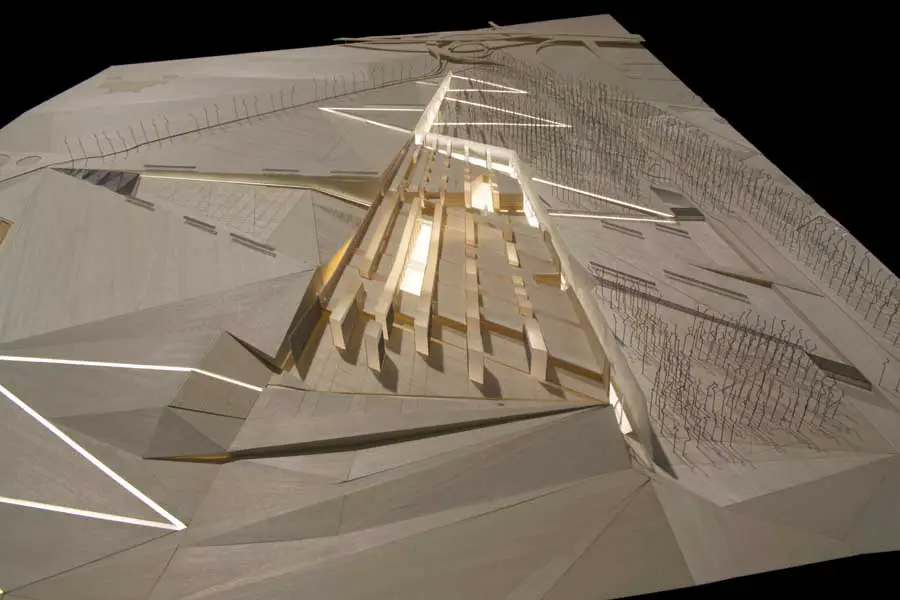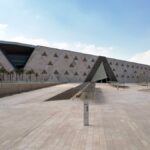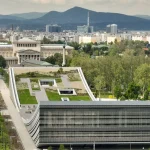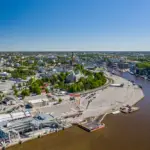Grand Egyptian Museum Cairo, Egyptian Building Project, Architect, Design Images
Grand Egyptian Museum, Egypt
Cairo Architecture Contest, Egypt design entry by heneghan.peng.architects, Dublin, Ireland
18 Jun 2008
Grand Museum of Egypt
Project Description
THE SITE: Between the Modern Complexities of Cairo and the Ancient Culture of the Pyramids
Model photo
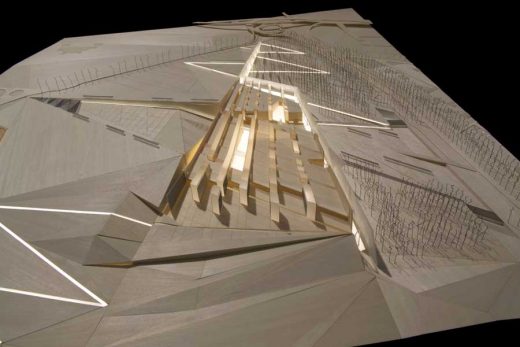
photo : Richard Davies
Three significant elements organise the New Museum within the site:
• The Plateau Edge, which divides the site into higher and lower sections.
• The View towards the Pyramids.
• The Cairo-Alexandria Approach.
Exterior Night rendering
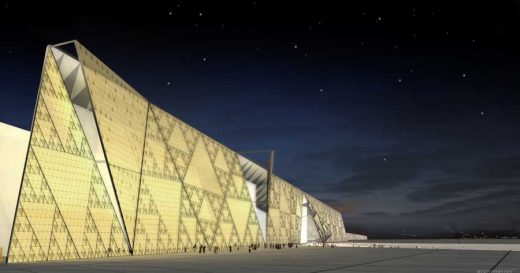
image : Archimation
ARCHITECTURAL PROPOSAL: Architecturalizing the Face of the Plateau
The proposal for the Grand Egyptian Museum begins by forming a new ‘edge’ to the Plateau, by creating a gentle slope as a thin veil of translucent stone structured by fractal geometry; opening and closing like foldings within the desert sand. As seen from Cairo, this newly inscribed surface of translucent stone constructs a dynamic identity; yet from within the museum, this surface traces a new visual trajectory towards the Pyramids. The wall of the museum can be understood as a rhythm of structural (physical) and spatial (effect-ive) foldings within the Plateau face, architecturalizing and intensifying its timeless surface.
Exterior Day rendering
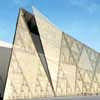
image : Archimation
BETWEEN THE SPACE OF THE PYRAMIDS: Relationship between the Museum and the Pyramids
The museum occupies a void within a 3-dimensional frame inscribed by a set of visual axes from the site to the three Pyramids. In plan, the lines that structure the museum are traced along these same visual lines. In section, the museum is structured along the ascent from the entrance and its parks to the Plateau level.
Model photo
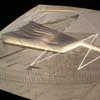
photo : Richard Davies
LOOKING TO CAIRO: Relationship between the Museum and Cairo
The New Museum is located at the first desert plateau outside Cairo, between the Pyramids and Cairo. It acts at the intersection between Modernity and Antiquity, literally redirecting the traveler from the modernity of Cairo and Alexandria to the Ancient Heritage of the Egyptians. Urbanistically, the museum is an ‘inscription’, inscribing the point at which the visitor changes direction from the city towards the Pyramids. The museum traces a new profile for the Plateau without competing with the Pyramids, utilising its’ siting and length to operate within the horizontal flows so indicative of modern vision and movement.
THE FIFTH FAÇADE: A New Horizon
The New Museum is sited at the intersection of two cones of vision, the View to the Pyramids and the View to Cairo. The View to the Pyramids is inscribed into the structural lines of the museum. The View to Cairo is traced by the path of the Nile Park which extends from the Dunal Park at the Plateau level, across the folds in the Roof and inscribed into the lines that define the Piazza as it extends to the city.
The structural folds that form the roof extend the dunal landscape of the site, maintaining the line of the desert plateau whilst constructing and spatialising a new horizon to view the city of Cairo.

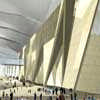
image : heneghan.peng.architects
SCULPTING WITH LIGHT: Movement Voids
From the scale of the site to the scale of the display case, light carves and defines the spaces of the new Museum Complex, from its Open-Air System of parks to its precisely controlled environments of artifacts.
Two Bands of Light divide the site into three bands:
Lower Plateau: Infrastructural area to the road side
Ascent to Plateau: Cultural area of the GEM
Upper Plateau: Natural area of the Dunal Park.
Light excavates the primary systems of movement through the plateau,
The light-filled Grand Staircase,
The Void of the Translucent Stone Wall
The Visual Causeway
The Digital Streams: Light voids that carve through the plateau to be occupied as needed by infrastructure.
THE PIAZZA/SCULPTURE COURT
The Piazza is an space of gathering and exchange that begins the transition from the outside to the inside drawing visitors from the entrance forecourt to the lower level of the entrance lobby The Piazza is an active space both at night and during the day remaining active even when the museum/conference facilities are closed.
THE LOBBY:
Extending the transition from outdoor space to museum and conference, the lobby is an in-between space that is a continuation of the Piazza’s exteriority into the planted shaded space of the lobby. The Nile Park flows through the lobby further integrating the exterior into the museum’s interior.
THE GRAND STAIRCASE: The Chronological Route
The Light-filled Grand Staircase ascends from the lobby to the permanent exhibition galleries on the top floor stopping off at special exhibitions, conservation workshops, temporary exhibition, and Archaeological Main Storage. The staircase is the chronological route within the museum, culminating in the view of the pyramids at the top of the stair. An identifiable reference point, the Grand Staircase allows visitors to easily navigate this vast collection.
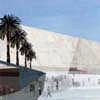
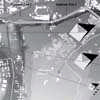
image : heneghan.peng.architects
THE GALLERIES: Hyper-textual nodes of Display Itineraries
The permanent exhibition areas on the top floor are organised in five thematic bands within the structure constructed by the visual axes to the pyramids, the sixth band being the chronological route of the grand stair. Hyper-textual nodes|Sculpture Garden Courts provide primary cross-movement between the thematic bands. The structural roof foldings follow the spatial organisation of the thematic bands; controlled light is brought in through the roof folds. A clear organisation is provided to a large space yet still allowing flexible modes of display.
The hyper-textural Nodes|Sculpture garden courts, which act as points of reference for the navigation of the collection also operate as rest-points for the visitor. One such point of reference is the court dedicated to Tutankhamun, Tutankhamun Light Court is a triangular cut into the building that registers on the facade the importance of the collection inside. In certain areas the floor is excavated to allow the visitor to drop down into special rooms under the galleries where special exhibits occur.
DIGITAL STREAMS
Paradoxically, the success of technological integration is its eventual disappearance-invisibility. In order to mesh technology into the new museum, technology is transformed into an architectural element; in this case into digital streams that operate spatially between the spatial bands that define thematic galleries. The walls that define the digital streams become the primary technology infrastructure element in the galleries supporting the interactive display requirements of individual vitrines.
THE GRAND EGYPTIAN MUSEUM
is not a singular museum in the traditional sense of the museum, It is constructed as a complex of different activities which contribute to a cultural environment that is centred about Egyptology By weaving different navigation routes through the complex, the world of ancient Egypt can be explored in different modes and levels. The museum is both a repository of cultural artifacts and an interactive cultural resource.
Grand Egyptian Museum – Building Information
Client: Technical Committee
Ministry of Culture, Egypt
Architects: heneghan.peng.architects
Structural, Civil Engineering, Traffic, Facades: Arup
Building Services, IT, Security, Fire: Buro Happold
Cost: Davis Langdon
Design Team Management: Davis Langdon Schumann Smith
Landscape: West 8
Lighting: Bartenbach Lichtlabor
Model Photography: Richard Davies
Grand Egyptian Museum images / information from heneghan.peng.architects
Location: Cairo, Egypt
Egypt Architecture
Contemporary Northeast Africa Architectural Projects
Grand Egyptian Museum Cairo : Entry
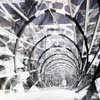
image from architect
Grand Egyptian Museum entry : Potiropoulos D+L Architects

image from architect
Comments / photos for the Grand Egyptian Museum Cairo page welcome

